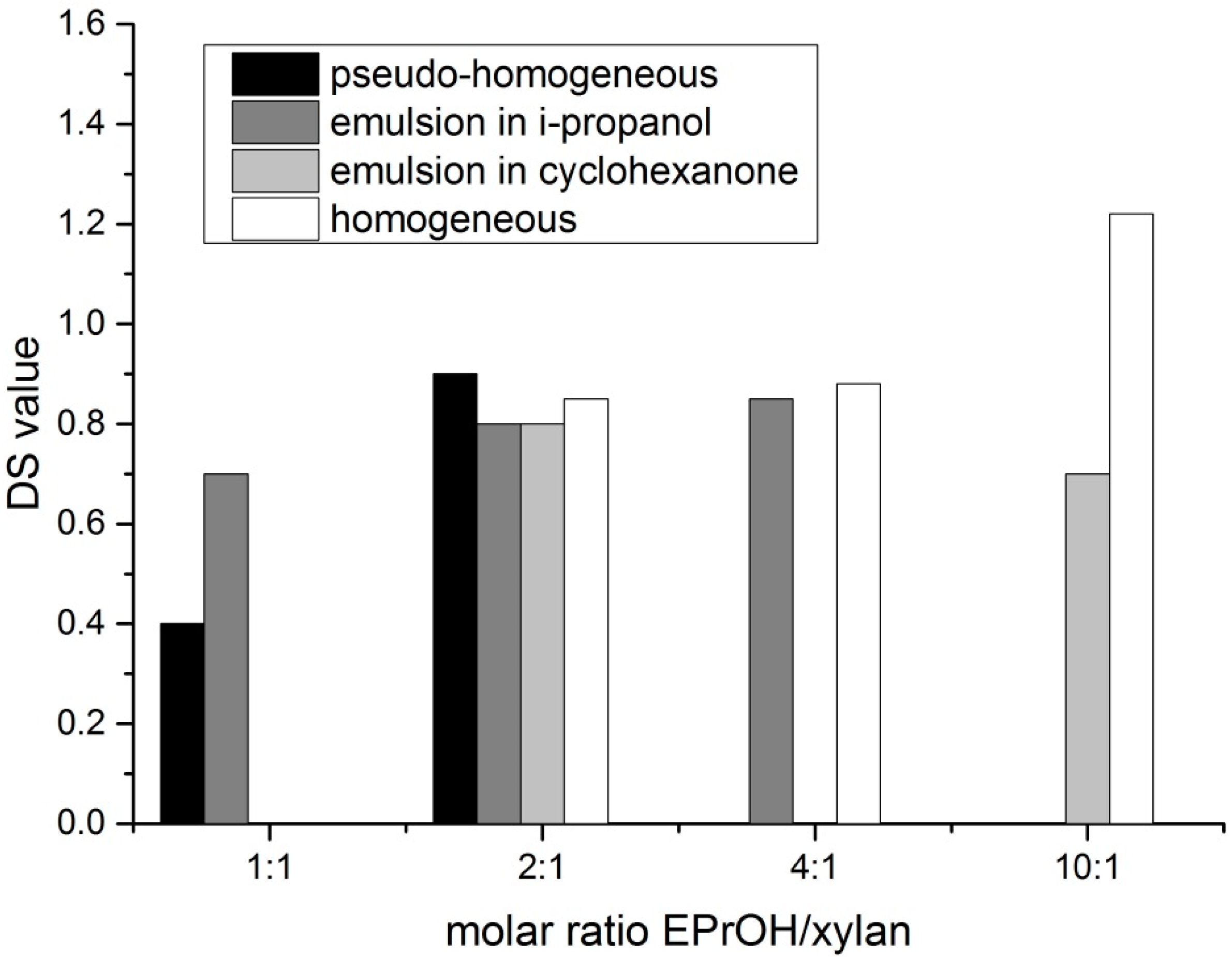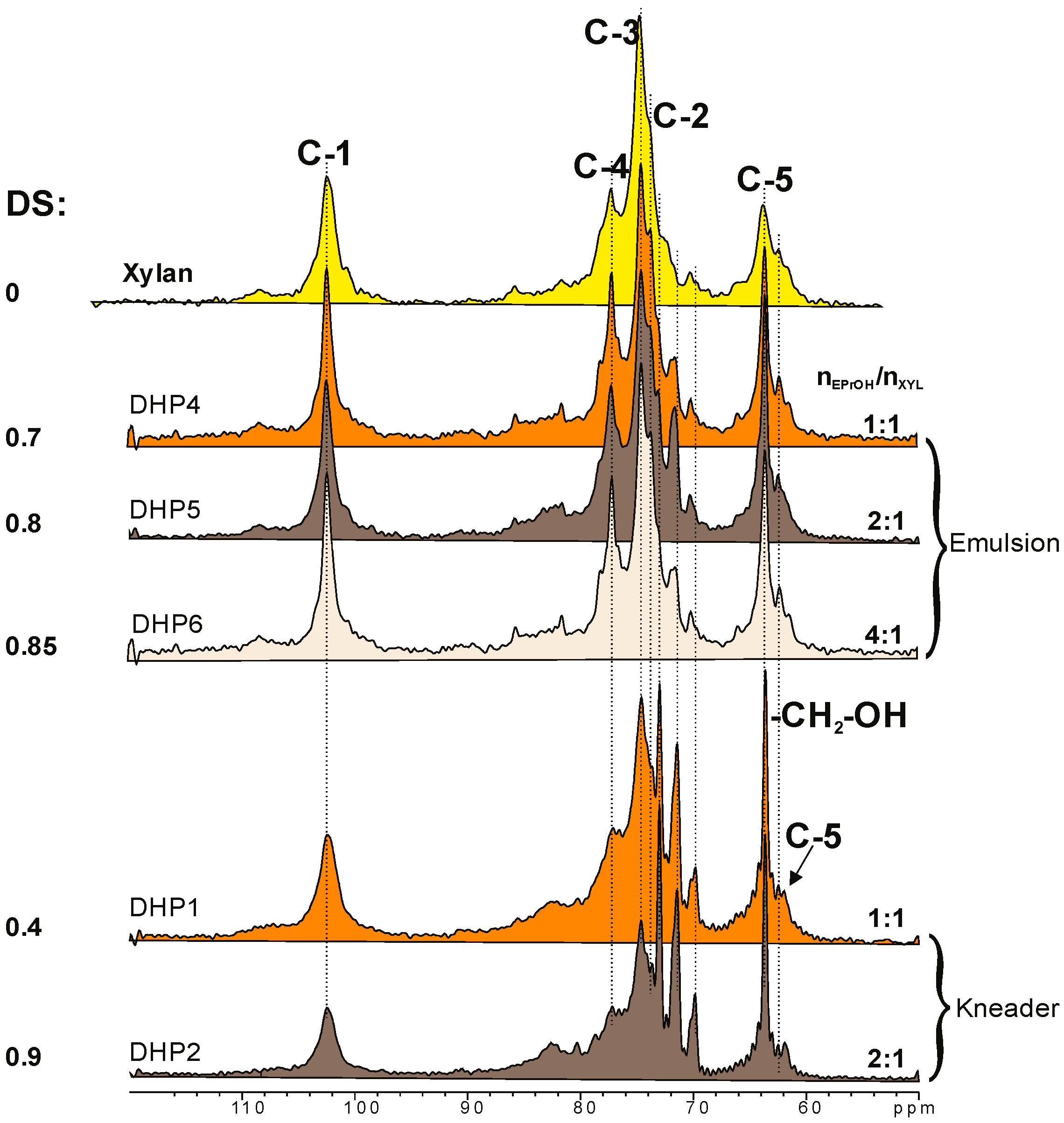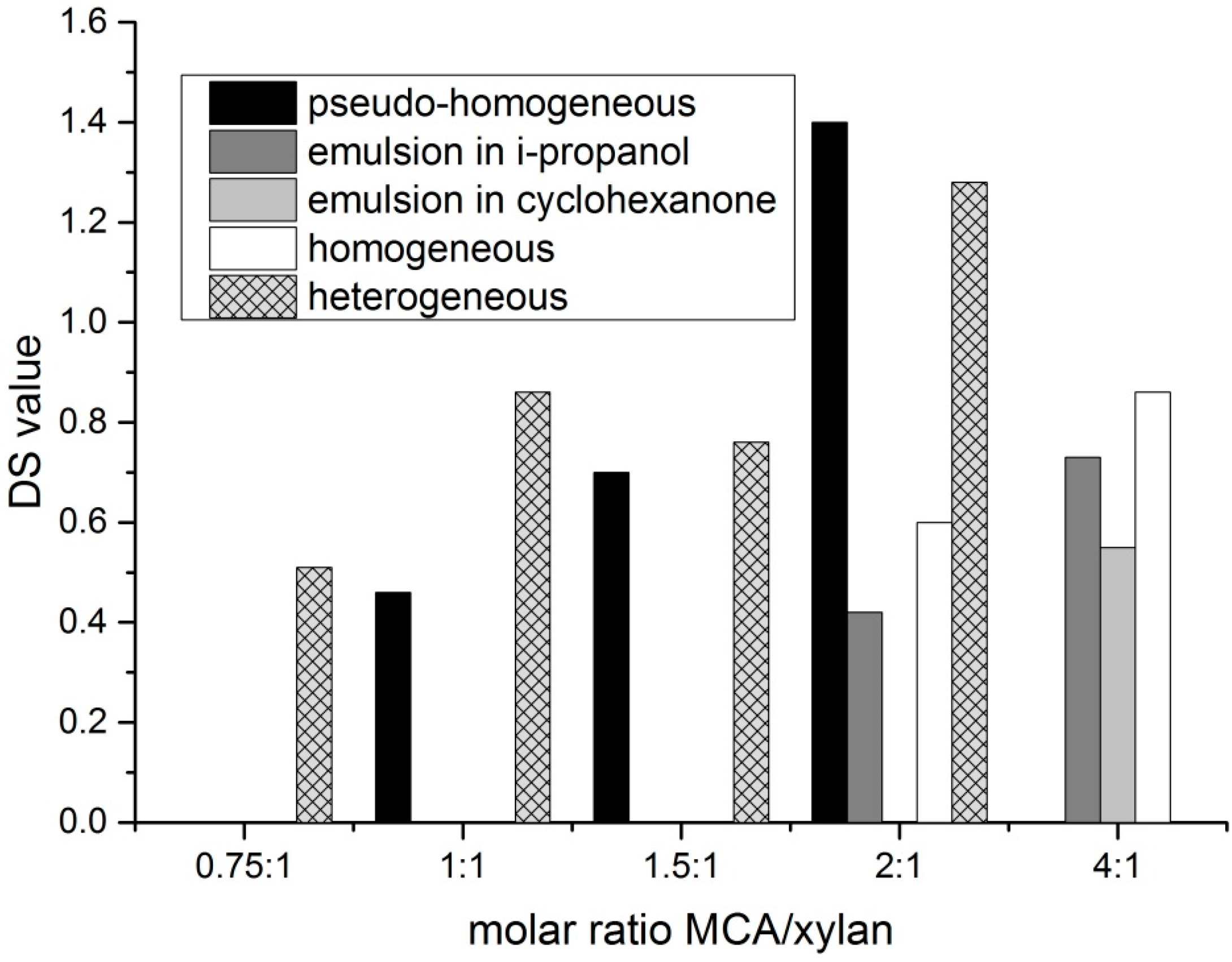Preparation and Characterization of Water-Soluble Xylan Ethers
Abstract
:1. Introduction
2. Materials and Methods
2.1. Synthesis of Dihydroxypropyl Xylan
2.1.1. Variant 1A—Pseudo Homogeneous Synthesis in a Kneader
2.1.2. Variant 2A—Reaction as Emulsion in 2-Propanol or in Cyclohexanone
2.1.3. Variant 3A—Homogeneous Syntheses
2.2. Syntheses of Carboxymethyl Xylan
2.2.1. Variant 1B—Pseudo Homogeneous Synthesis in a Kneader
2.2.2. Variant 2B—Reaction as Emulsion in 2-Propanol or in Cyclohexanone
2.2.3. Variant 3B—Homogeneous Synthesis
2.2.4. Variant 4B—Heterogeneous Method (Slurry)
2.3. Measurements
2.3.1. Solid State 13C-NMR Spectroscopy for the Determination of the Dihydroxypropyl Content
2.3.2. Determination of the Carboxymethyl Content by ICP-OES
2.3.3. Solubility
3. Results and Discussion
3.1. Synthesis of Dihydroxypropyl Xylan
3.2. Syntheses of Carboxymethyl Xylan
3.3. Dissolution Behaviour of the Xylan Ether
4. Conclusions
Acknowledgments
Author Contributions
Conflicts of Interest
References
- Gabrielii, I.; Gatenholm, P. Preparation and properties of hydrogels based on hemicellulose. J. Appl. Polym. Sci. 1998, 69, 1661–1667. [Google Scholar] [CrossRef]
- Whistler, R.L. Hemicellulose. In Industrial Gums, Polysaccharides and Their Derivatives; Whistler, R.L., BeMiller, J.N., Eds.; Acedemic Press: Orlando, FL, USA, 1993; pp. 295–308. [Google Scholar]
- Ebringerova, A.; Heinze, T. Xylan and Xylan derivatives—Biopolymer with valuable properties, 1. Naturally occurring xylan structures, isolation procedures and properties. Macromol. Rapid Commun. 2000, 21, 542–556. [Google Scholar] [CrossRef]
- Chaa, L.; Joly, N.; Lequart, V.; Faugeron, C.; Mollet, J.-C.; Martin, P.; Morvan, H. Isolation, characterization and valorization of hemicelluloses from Aristida pungens leaves as biomaterial. Carbohydr. Polym. 2008, 74, 597–602. [Google Scholar] [CrossRef]
- Verbruggen, M.A.; Beldman, G.; Voragen, A.G. Enzymatic degradation of sorghum glucuronoarabinoxylans leading to tentative structures. Carbohydr. Res. 1998, 306, 275–282. [Google Scholar] [CrossRef]
- Stephan, A.M. The Polysaccharides; Aspinall, G.O., Ed.; Academic Press: New York, NY, USA, 1983; Volume 2, p. 120. [Google Scholar]
- Timell, T.E. Recent progress in the chemistry of wood hemicelluloses. Wood Sci. Technol. 1967, 1, 45–70. [Google Scholar] [CrossRef]
- Puls, J. Chemistry and biochemistry of hemicelluloses: Relationship between hemicellulose structure and enzymes required for hydrolysis. Macromol. Symp. 1997, 120, 183–196. [Google Scholar] [CrossRef]
- Wilkie, K.C.B. The hemicellulose of grass and cereals. Adv. Carbohydr. Chem. Biochem. 1979, 36, 215–264. [Google Scholar]
- Fincher, G.B.; Stone, B.A. Advance in Cereal Science and Technology; Pommeranz, Y., Ed.; American Association of Cereal Chemists: St. Paul, MN, USA, 1986; Volume VIII, p. 207. [Google Scholar]
- Izydorczyk, M.; Biladeris, C.G. Cereal arabinoxylans: Advances in structure and physicochemical properties. Carbohydr. Polym. 1995, 28, 33–48. [Google Scholar] [CrossRef]
- Saake, B.; Erasmy, N.; Kruse, T.; Schmekal, E.; Puls, J. Ioslation and characterization of arabinoxylan from oat spelts. In Hemicellulose: Science and Technology; ACS Symposium, Series; Gatenholm, P., Tenkanen, M., Eds.; American Chemical Society: Washington, DC, USA, 2003. [Google Scholar]
- Ebringerova, A. Structural diversity and application potential of hemicelluloses. Macromol. Symp. 2005, 232, 1–12. [Google Scholar] [CrossRef]
- Available online: http://www.factfish.com/de/statistik/hafer,%20produktionsmenge (accessed on 7 September 2016).
- Ng, A.; Greenshields, R.N.; Waldron, K.W. Oxidative cross-linking of corn-bran hemicellulose: Formation of ferulic acid dehydrodimers. Carbohydr. Res. 1997, 303, 459–463. [Google Scholar] [CrossRef]
- Gabrielii, I.; Gatenholm, P.; Glasser, W.G.; Jain, R.K.; Kenne, J. Separation, characterization and hydrogel-formation from aspen wood. Carbohydr. Polym. 2000, 43, 367–374. [Google Scholar] [CrossRef]
- Zhang, P.; Whistler, R.L. Mechanical properties and water vapor permeability of thin film from corn hull arabinoxylan. J. Appl. Polym. Sci. 2004, 93, 2896–2902. [Google Scholar] [CrossRef]
- Fang, J.M.; Fowler, P.; Tomkins, J.; Hill, C.A.S. Preparation and characterization of methylated hemicelluloses from wheat straw. Carbohydr. Polym. 2002, 15, 285–293. [Google Scholar] [CrossRef]
- Ebringerova, A.; Hromadkova, Z. Xylan of industrial and biomedical importance. Biotechnol. Genet. Eng. Rev. 1999, 16, 325–346. [Google Scholar] [CrossRef] [PubMed]
- Hettrich, K.; Fischer, S.; Schröder, N.; Engelhardt, J.; Drechsler, U.; Loth, F. Derivatization and characteriization of xylan from oat spelts. Macromol. Symp. 2005, 232, 37–48. [Google Scholar] [CrossRef]
- Heinze, T.; Koschella, A.; Ebringerova, A. Chemical functionalization of xylan: A short review. In Hemicellulose: Science and Technology; ACS Symposium, Series; Gatenholm, P., Tenkanen, M., Eds.; American Chemical Society: Washington, DC, USA, 2003. [Google Scholar]
- Abad-Romero, B.; Haltrich, D.; Potthast, A.; Rosenau, T.; Sixta, H.; Kosma, P. Isolation, synthesis and derivatization of xylodextrins. Macromol. Symp. 2005, 232, 193–197. [Google Scholar] [CrossRef]
- Nypelö, T.; Laine, C.; Masaaki, A.; Tammelin, T.; Hennings, U. Etherification of wood-based hemicelluloses for interfacial activity. Biomacromolcules 2016, 17, 1894–1901. [Google Scholar] [CrossRef] [PubMed]
- Puls, J.; Schröder, N.; Stein, A.; Janzon, A.; Saake, B. Xylan from oat spelts and birch kraft pulp. Macromol. Symp. 2005, 232, 85–92. [Google Scholar] [CrossRef]
- Klemm, D.; Philipp, B.; Heinze, T.; Heinze, U.; Wagenknecht, W. Comprehensive Cellulose Chemistry; Wiley-VCH: Weinheim, Germany, 1998; Volume 1, p. 139. [Google Scholar]
- Volkert, B.; Wagenknecht, W. Substitution patterns of cellulose ethers—Influence of the synthetic pathway. Macromol. Symp. 2008, 262, 97–118. [Google Scholar]
- Laschewsky, A.; Rekai, E.D.; Wischerhoff, E. Tailoring of Stimuli-Responsive Water-Soluble Acrylamide and Methacrylamide Polymers. Macromol. Chem. Phys. 2001, 202, 276–286. [Google Scholar] [CrossRef]
- Christova, D.; Ivanova, S.; Ivanova, G. Water-soluble temperature responsive poly(vinyl alcohol-co-vinylacetal)s. Polym. Bull. 2003, 50, 367–372. [Google Scholar] [CrossRef]
- Steinhauer, W.; Hoogenboom, R.; Keul, H.; Moeller, M. Block and Gradient Copolymers of 2-Hydroxyethyl Acrylate and 2-Methoxyethyl Acrylate via RAFT: Polymerization Kinetics, Thermoresponsive Properties, and Micellization. Macromolecules 2013, 46, 1447–1460. [Google Scholar] [CrossRef]
- Meiswinkel, G.; Ritter, H. Polymers from 1-Vinyl-2-(hydroxymethyl)imidazole in Water: Altering from UCST to LCST Behavior via O-Ethylation. Macromol. Chem. Phys. 2014, 215, 682–687. [Google Scholar] [CrossRef]
- Congdon, T.; Shaw, P.; Gibson, M.I. Thermoresponsive, well-defined, poly(vinyl alcohol) co-polymers. Polym. Chem. 2015, 6, 4749–4757. [Google Scholar] [CrossRef]









| Sample | nEPrOH/nxylan | nNaOH/nxylan | DS | Method |
|---|---|---|---|---|
| DHPX1 | 1:1 | 0.3:1 | 0.40 | pseudo-homogeneous, 60 °C, 4 h |
| DHPX2 | 2:1 | 0.23:1 | 0.90 | pseudo-homogeneous, 60 °C, 4 h |
| DHPX3 | 2:1 | 1:1 | 0.90 | pseudo-homogeneous, 60 °C, 4 h |
| DHPX4 | 1:1 | 2.05:1 | 0.70 | emulsion, i-propanol, 25 °C, 18 h |
| DHPX5 | 2:1 | 2.05:1 | 0.80 | emulsion, i-propanol, 25 °C, 18 h |
| DHPX6 | 4:1 | 2.05:1 | 0.85 | emulsion, i-propanol, 25 °C, 18 h |
| DHPX7 | 2:1 | 2.05:1 | 0.77 | emulsion, cyclohexanone, 25 °C, 18 h |
| DHPX8 | 10:1 | 2.05:1 | 0.70 | emulsion, cyclohexanone, 25 °C, 18 h |
| DHPX9 | 2:1 | 1.2:1 | 0.85 | homogeneous, 25 °C, 24 h |
| DHPX10 | 4:1 | 2.05:1 | 0.88 | homogeneous, 25 °C, 24 h |
| DHPX11 | 4:1 | 2.05:1 | 0.93 | homogeneous, 25 °C, 95 h |
| DHPX12 | 10:1 | 2.05:1 | 1.22 | homogeneous, 25 °C, 95 h |
| Sample | nMCA/nxylan | nNaOH/nxylan | DS | Method |
|---|---|---|---|---|
| CMX1 | 1:1 | 4.9:1 | 0.46 | pseudo-homogeneous, 70 °C, 3 h |
| CMX2 | 1.5:1 | 4.7:1 | 0.73 | pseudo-homogeneous, 70 °C, 4 h |
| CMX3 | 2:1 | 9.25:1 | 1.40 | pseudo-homogeneous, 70 °C, 4 h |
| CMX4 | 2:1 | 9.25:1 | 0.42 | emulsion, i-propanol, 60 °C, 4 h |
| CMX5 | 4.2:1 | 9.25:1 | 0.73 | emulsion, i-propanol, 60 °C, 4 h |
| CMX6 | 4.2:1 | 9.25:1 | 0.55 | emulsion, cyclohexanone, 60 °C, 4 h |
| CMX7 | 2:1 | 4.4:1 | 0.60 | homogeneous, 50 °C, 3.5 h |
| CMX8 | 2:1 | 4.4:1 | 0.41 | homogeneous, 50 °C, 8 h |
| CMX9 | 2:1 | 4.4:1 | 0.30 | homogeneous, 25 °C, 24 h |
| CMX10 | 2:1 | 4.4:1 | 0.29 | homogeneous, 50 °C, 72 h |
| CMX11 | 4.2:1 | 9.25:1 | 0.86 | homogeneous, 50 °C, 3.5 h |
| CMX12 | 0.75:1 | 0.9:1 | 0.51 | heterogeneous, 50 °C, 4 h |
| CMX13 | 1:1 | 2.2:1 | 0.86 | heterogeneous, 50 °C, 4 h |
| CMX14 | 1.5:1 | 2.2:1 | 0.76 | heterogeneous, 50 °C, 4 h |
| CMX15 | 2:1 | 4.4:1 | 1.28 | heterogeneous, 50 °C, 4 h |
© 2017 by the authors. Licensee MDPI, Basel, Switzerland. This article is an open access article distributed under the terms and conditions of the Creative Commons Attribution (CC BY) license (http://creativecommons.org/licenses/by/4.0/).
Share and Cite
Hettrich, K.; Drechsler, U.; Loth, F.; Volkert, B. Preparation and Characterization of Water-Soluble Xylan Ethers. Polymers 2017, 9, 129. https://doi.org/10.3390/polym9040129
Hettrich K, Drechsler U, Loth F, Volkert B. Preparation and Characterization of Water-Soluble Xylan Ethers. Polymers. 2017; 9(4):129. https://doi.org/10.3390/polym9040129
Chicago/Turabian StyleHettrich, Kay, Ulrich Drechsler, Fritz Loth, and Bert Volkert. 2017. "Preparation and Characterization of Water-Soluble Xylan Ethers" Polymers 9, no. 4: 129. https://doi.org/10.3390/polym9040129





